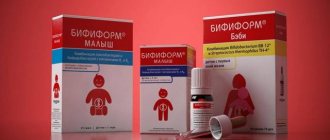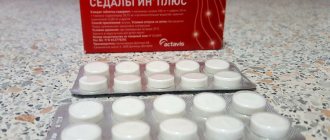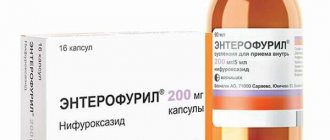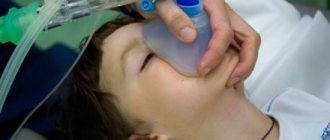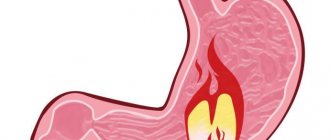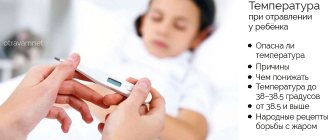Probably, almost every parent has encountered the problem of food poisoning in a child of younger and middle age. Nausea, vomiting, diarrhea, high fever, lack of appetite and weakness - as a rule, evidence of food poisoning is the appearance of these symptoms.
For a quick recovery and restoration of the baby’s body, it is necessary not only to follow the doctor’s instructions regarding taking any medications, but also to pay attention to the child’s nutrition. What can you feed a child after poisoning, how to properly prepare drinks and dishes, what foods should be limited or completely excluded from the diet, how to improve the condition of the affected intestinal microflora - we will consider these and other questions in more detail.
A gentle, balanced diet is an important tool for helping the body recover after food poisoning.
Features of the child's body
Most often, children experience food poisoning, which is divided into non-infectious and food poisoning (food poisoning). In any case, the child’s body needs a balanced diet that will not overload the digestive tract.
Weakness and fever after poisoning in a child often complicate the course of the disease. When bacteria enter the intestines, the beneficial microflora dies and cannot resist aggressive streptococci or rotaviruses. Immunity decreases, the mucous membrane of the stomach and intestines becomes inflamed. Children's appetite decreases, they refuse even their most favorite foods, lose strength, and sleep a lot.
For full development, a child’s body requires a certain amount of minerals, proteins, and vitamins. He gets them from a balanced and varied diet. If the diet for poisoning has not been selected, dysbiosis occurs in children. For several months after intoxication, they more often suffer from acute respiratory viral infections, influenza, and other infections. Within 4-6 weeks, the child may complain of abdominal pain and have upset bowel movements. Disorders in the digestive system are often accompanied by pancreatitis, and liver function is impaired. To reduce the risk of such complications, it is necessary to follow a special diet for food poisoning in children.
Symptoms
Parents can understand that their child has been poisoned by paying attention to the following signs:
- Loss of appetite.
- Increased heart rate.
- Paleness of the skin.
- If a toxic infection is present, then vomiting is followed by fever and diarrhea.
- Deterioration in health, which is accompanied by weakness, moodiness, lethargy, pain and tightening of the legs. As the pathological process develops, symptoms such as vomiting and nausea appear.
Important! The first signs of food poisoning appear 4-6 hours after the pathogen enters the intestines.
This kind of condition can be dangerous for the health and life of the child. If we are talking about a baby under the age of 1 year, then with a fluid loss of 10% of the total body weight, the outcome can be fatal.
Rules for feeding a child in case of poisoning
Purpose of a strict diet:
- maintain the balance of vitamins, amino acids, water;
- strengthen defenses;
- relieve irritation of the stomach walls;
- reduce the level of toxic substances in the body;
- maintain basic blood counts at a high level.
In the first days after poisoning, it is recommended to sharply reduce the child’s diet. You can even not feed him at all, but make sure that he drinks a lot of liquid - water, fruit drinks, compotes. Drinks should be low-sweet or completely sugar-free. If the patient asks for food, you can give him some crackers or stale white bread. As the child's condition improves, his diet gradually expands.
Important! Any restrictions or new products in the acute period must be agreed with your doctor. He will help you create a menu according to the age of the little patient.
The diet for poisoning in a child is based on the following rules:
- all dishes must be pureed to a liquid puree without lumps;
- For cooking, it is better to use a double boiler; bake foods without oil;
- You should not give too hot or very cold dishes, the food should be warm;
- the addition of spices and sauces is excluded.
Food is given to the baby in small portions. They are reduced to several spoons so as not to overload the inflamed lining of the stomach. The next meal is repeated after 2-3 hours. Parents should make sure that the child does not vomit during this period. Komarovsky and some doctors recommend not waiting for the feeling of hunger to appear: a baby at 2 years old will not yet be able to formulate a desire, so he needs to be offered food.
Nuances of preparation
- All consumed products must be thoroughly washed and doused with boiling water;
- All products must be heat treatable. You should not consume half-raw, undercooked or undercooked food;
- Wash your hands thoroughly before cooking or eating;
- In case of poisoning, it is necessary to exclude fatty, overcooked, and salty foods from the diet;
- It is necessary to reduce the consumption of carbohydrates and fats;
- It is recommended to regularly disinfect all kitchen utensils;
- It is necessary to follow the rules for storing incompatible products;
- It is necessary to monitor the expiration date of consumed products;
How to give water to a child who is vomiting
Many parents do not know what to give their child with food poisoning on the first day. It should be remembered that diarrhea provokes dehydration. With diarrhea and vomiting, not only water, but also useful substances are intensively removed, which greatly worsens the condition of the baby. For vomiting and diarrhea, you can give the patient healthy drinks:
- unsweetened fruit drinks without pulp;
- natural juices diluted with water;
- weak black or green tea;
- infusion of chamomile or rosehip;
- mineral water (the gas is pre-released).
Sometimes the baby is given compotes made from dried fruits. To prepare them, you cannot take prunes and pears, which stimulate intestinal motility. Raisins, dried apricots, and apples provide a light fixing effect. In addition, these dried fruits contain potassium, sodium and magnesium.
When a child is poisoned, food often provokes a gag reflex. Young children react painfully to its manifestation. Some get scared and flatly refuse any drink, spitting out the water. In this situation, medical assistance cannot be avoided. In the hospital, a small patient is given intravenous drips of glucose-saline solutions, which restore water and electrolyte balance.
Attention! Excessive loss of water is fraught with dangerous consequences for the child’s body. The temperature rises sharply, the functioning of the heart and kidneys is disrupted. This can be fatal. If the baby has not drunk 200–500 ml of liquid in a day, he must be taken under the supervision of an infectious disease specialist.
At home, on the first day, fruit drinks and compotes can be alternated with drugs containing antiemetic and dehydrating components: Regidron, Oralit, Glucosolan. Such water-salt solutions are indispensable when refusing food; they soothe irritated stomach walls. They help normalize the production of enzymes responsible for digesting food and stimulate appetite.
What can you feed a child if he is poisoned?
In the next day after fasting, the following products are added to the menu in case of poisoning in children:
- banana pieces mashed with a fork;
- steamed pieces of broccoli;
- homemade yogurt;
- low-fat kefir.
It is better to purchase dairy products from the children's kitchen or prepare them yourself. To improve the taste, do not add sugar or fruit to them. You can use ready-made purees for complementary feeding, but only after checking the expiration date and composition. For infants, recommendations are more individual, so read about poisoning due to breastfeeding here.
When choosing what you can eat after your child vomits, you should choose light cereals. It is better to cook them in small portions from oatmeal or rice. They cover the gastric mucosa with a thin film, relieve attacks of nausea and saturate the body with minerals. Such dishes are prepared in purified water without adding oil or sugar, and pureed with a blender into a homogeneous mass.
When interest in food appears, the diet after food poisoning in children expands to several healthy dishes:
- vegetable soups;
- mashed cottage cheese;
- chicken breast pate without fat;
- puree from steamed vegetables (carrots, zucchini, potatoes).
A 4-year-old child can be offered low-fat broth cooked with the addition of vegetables. Pieces of oven-dried white bread, crackers or biscuits are offered with the broth. In combination with medications, a proper diet prevents the appearance of spasms and colic and stops intestinal upset. If it is difficult to decide what to feed your child after diarrhea, you should consult your doctor.
Food Processing Methods
In addition to the fact that a gentle diet provides for a correct diet, parents need to listen to recommendations for cooking. In order for products to be quickly absorbed even if the gastrointestinal tract is still injured, they need to be well boiled. This mostly applies to porridges, since boiled vegetables can always be ground in a blender or rubbed through a fine sieve.
If there are no such devices in the kitchen, then you can purchase special ready-made baby food. It will be adapted even for the smallest patients, representing a ready-made mass, ground into a paste. It can be:
- porridge,
- meat and fish soufflés,
- vegetable puree.
Be sure to make sure that the contents of the jar do not include sugar. But it’s better not to be lazy and prepare a fresh portion of food for the victim every time.
So that the stomach can begin to actively digest the incoming “fuel”, it should be helped at first. For this purpose, all products are preliminarily:
- boiled
- stewed,
- pour over steam in a double boiler or multicooker.
Any dish should be served warmed up, but not hot.
Menu to improve digestion
The list of foods allowed for children in case of poisoning is supplemented after a few days with light and nutritious dishes:
- baked apples;
- aromatic berry jelly;
- steam omelette;
- boiled low-fat fish;
- tender cutlets cooked in a double boiler.
For the first 5-7 days, the baby is fed fractionally, dividing the daily amount of food into 6 times. In this case, the stomach is not overloaded, digestive juice is released more abundantly. An approximate diet for a child after poisoning is very easy to prepare:
- Breakfast: unsweetened oatmeal porridge in water with 1 teaspoon of butter, 1 boiled egg, fruit broth with crackers.
- Lunch: pureed soup or broth with dried bread, baked potatoes, steamed vegetables, jelly.
- Dinner: zucchini or carrot puree, baked apple with cottage cheese, steamed fish, tea.
Small snacks in the form of compote, jelly, and a sandwich with pate will complement the menu. Between meals, the patient must be offered clean water acidified with lemon juice.
Dish recipes
Meat soufflé
- Meat - 60 g;
- wheat bread - 5 g;
- egg -1/4 pcs.,
- butter - 1/2 teaspoon;
- broth - 1-2 tbsp. spoons.
Cut the meat, cleaned of films and tendons, into pieces and simmer in a small amount of water until half cooked. Then add wheat bread soaked in cold water, pass everything through a fine mesh meat grinder twice, add broth, egg and stir. Place this mass in a pan, greased with oil and sprinkled with breadcrumbs, and bake, covering the pan, in the oven in a water bath. Cooking time: 20-25 minutes.
What not to give in case of poisoning
It is better to make the diet lighter in children after food poisoning. During treatment, cow's milk in any form is prohibited. It only worsens diarrhea and interferes with the restoration of microflora. It is replaced with fermented milk products, the amount of which increases as you recover.
You should not feed a child after poisoning with fatty, salty and spicy foods, therefore the following are excluded:
- chocolate and sweets;
- sausages;
- sour fruits;
- any sauces, mayonnaise;
- carbonated drinks;
- pork soups;
- mushroom dishes.
Even ordinary pasta is difficult to digest and worsens the condition of the inflamed mucous membrane of the stomach and intestines. Fried meat, sausages and ketchup are dangerous. New products should be introduced into the menu without haste 2-3 weeks after the stool is completely restored.
Diet features
In the first days, food in case of poisoning in children should be semi-liquid. All dishes are prepared without adding pepper, bay leaves, or other spices. It is necessary to achieve a neutral taste. Steamed vegetables are boiled to a soft paste and gently mashed with a few tablespoons of vegetable broth. Gradually, boiled porridge from millet and oatmeal is introduced into the diet.
If you have no appetite, it is difficult to get your baby to try food. Therefore, dietary dishes for children in case of poisoning should be served in bright plates and decorated with boiled vegetables. This will arouse your baby's interest and whet his appetite. It is recommended to put a sprig of herbs, a piece of butter, and small cubes of crackers on a plate.
How to choose the right products
To avoid the development of poisoning in a child, adults should learn to carefully choose good quality products that will benefit the whole family:
- It is better to refuse to purchase frozen semi-finished products, which rarely contain high-quality meat.
- Don't be shy about smelling chicken, meat or fish; you need to ask the seller for documents confirming their freshness.
- It is better to choose domestic fruits and vegetables that are in season and do not contain pesticides or nitrates.
- Be sure to pay attention to the expiration date of the product, the composition on the label, and the safety of the packaging.
- It is recommended to buy baby purees in glass containers and inspect the consistency and color of the product.
It is strictly not recommended to purchase meat or milk from your hands. Food poisoning often occurs after visiting cafes or eateries. Therefore, on long walks with children, you should take with you homemade crackers, biscuits or banana, and a thermos with tea or fruit juice.
